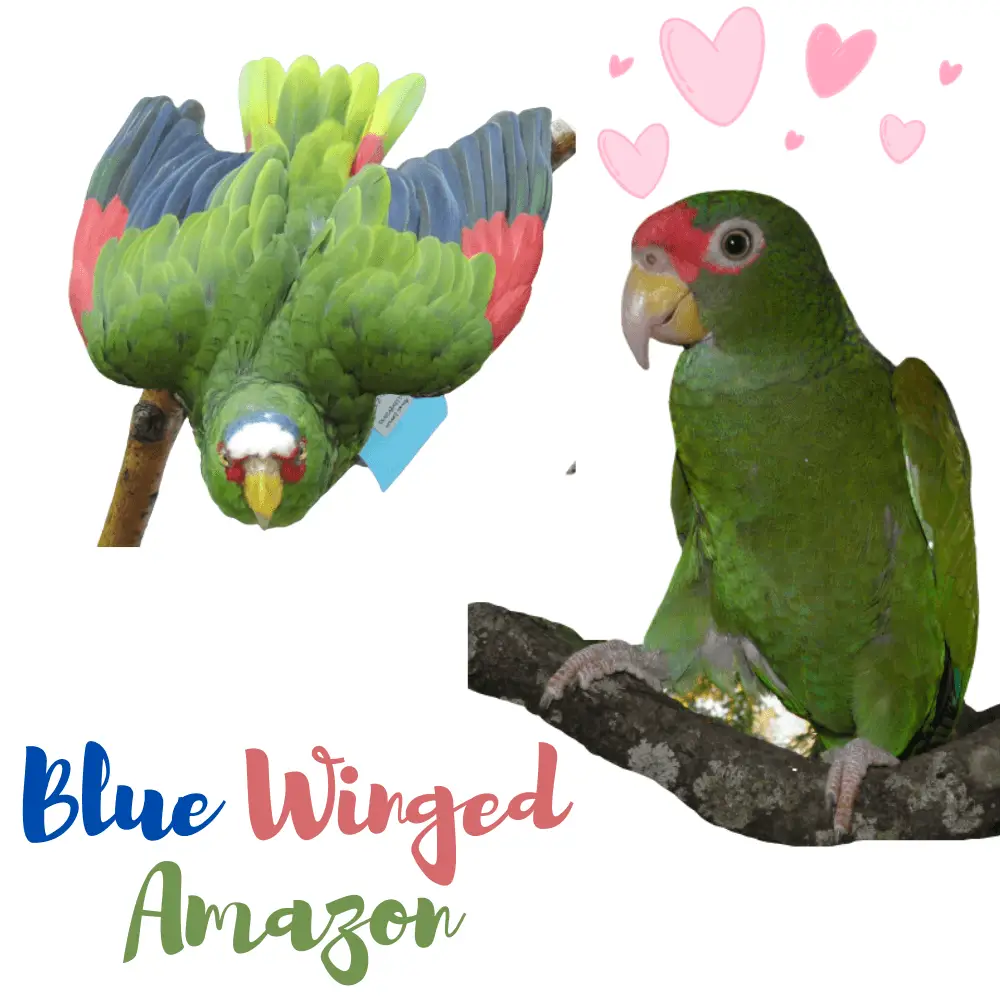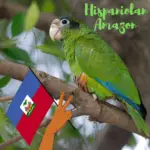
The Blue-winged Amazon (Amazona gomezgarzai) is a parrot species of amazon parrots in the Psittacidae family.
Systematic
-
Order: Psittaciformes
-
Family: Psittacidae
-
Gender: Amazon
-
Species: brasiliensis
Descriptor
Biometrics
Description
This bird is about 27 cm long. It has an essentially green plumage with a red forehead, more extensive in the male than in the female.
Genetically, it is very close to the White-fronted Amazon (Amazona albifrons), which lives in the same region and habitat. The separation of species, which do not hybridize, is dated to about 120,000 years ago.
Systematics
The species Amazona gomezgarzai was described in 2017 by two ornithologists, Tony Silva and Antonio Guzmán” and two geneticists, Adam Urantowka and Paweł Mackiewicz.
The NCBI considers this bird as a subspecies of Amazona albifrons, under the taxon Amazona albifrons gomezgarzai.
Behavior
Its behavior is similar to that of the green-cheeked Amazon (Amazona viridigenalis). It feeds on seeds, leaves, and fruits (including those of False Acacia, Carao, and Acacia gaumeri).
It moves in small groups of less than twelve individuals.
Voice singing and shouting
In-flight, the blue-cheeked Amazon emits “kraaaa kraaaa” somewhat similar to a crow croaking. In other circumstances, it produces “kli kli” and “krayo” quite identical to those of blue-fronted amazons (Amazona aestiva).
Habitat
This species is confined to a thin coastal strip formed by lowland forests and wetlands. This region, which has a rather complex structure, includes both wet woodlands, freshwater marshes, mangroves, and resting (sandy and salty soils, close to the sea, and covered with characteristic herbaceous plants).
Its favorite habitats usually include a fairly inextricable network of canals, wetlands, and swamps. The trees that make up the forests are typical of the genus Luehea or Andira. The vegetation that dominates in small islands is formed by halophyte plants (able to adapt to salty soils).
Many blue-cheeked Amazons are sedentary in flooded forests, probably because they provide a large selection of nesting sites. Although they have been spotted up to 700 m in the Paranà, these birds do not usually climb above 300 or 400 meters above sea level.
Behavior
The Blue-cheeked Amazon often forms common dormitories in mangroves, at least at certain times of the year. There is a report from 1985 that shows a group of more than 750 individuals. Nevertheless, most of the time, this bird seeks its food in pairs or small bands with a maximum of twenty elements. The Blue-cheeked Amazon is mostly sedentary. There may be some local migratory movements during the winter period (May-August), with some birds heading inland for sustenance.
Diet
Blue-cheeked Amazons have a vegetarian or frugivorous diet. It seems that the fruits of a local Clusiaceae (Calophyllum brasiliense) represent a primordial part of its diet. The fruits of some trees of the genus Syagrus and Psidium are also taken in quantity. Red flowers and fruits of erythrina often complete the menu. A few insects are rarely caught.
Reproduction
Nesting reproduction Blue-cheeked Amazons nest in the cavities of dead or healthy trees. The trees that serve as their pantry are also those that serve them for nesting.
Tree termite mounds are also sometimes used. The nest is usually placed at a great height, but it can be located as low as a meter when it overlooks a body of water. Most of the time, Amazons choose flooded forests or mangroves to establish their nests.
The breeding season runs from September to February, sometimes extending into April. The female lays 3 or 4 eggs that are incubated for about 27 or 28 days. The young leave the nest after 50 to 55 days or 7 to 8 weeks.
Distribution
The Blue-cheeked Amazon is endemic to southeastern Brazil, in the states of Sao Paulo and Paranà. It occupies a stretch of coastline that runs from Itanhaem to Paranagua Bay and a little further south to Garatuba. This bird is probably also present in the extreme northeast of Santa Catarina and the Rio Grande do Sul, although there are no reports from these 2 states. Given the small size of its range, the species has no geographical variations and is considered monotypic.
Threats – Protection
In the 70s, the species quickly decreased, from 4500 individuals to nearly 2000. It seems that currently, the population has risen to around 4500 to 5000 birds. Two main dangers threaten this species. The first of these is the loss or deterioration of its habitat.
Natural wetland habitats are being converted into breeding grounds for livestock and water buffaloes. Palm trees and mangroves are regularly cut or deteriorated to meet the requirements of tourism which are highly developed in this region.
The second threat is poaching. Since the blue-cheeked Amazon is a very popular pet bird, the young are taken directly from the nest where they are easy prey. In 1991 and 1992 alone, more than 350 Amazons were illegally traded. “Scouts” often damage cavities when they take hold of their victims, which further increases the damage at the expense of this species and significantly reduces the number of nesting sites. For the reasons set out above, the IUCN has classified the species as Vulnerable.
References used
- Vol. 5 – Handbook of the Birds of the World, Josep del Hoyo-Andrew Elliott-Jordi sargatal
- Parrots of the World, Joseph M. Forshaw
- Parrots, Tony Juniper
- ARKive, Christopher Parsons
- Avibase, Lepage Denis
- World Parrot Trust,
- Wikipédia, Wikipedia, The Free Encyclopedia
- IOC World Bird List (v12.1), Gill, F and D Donsker (Eds). 2022.
Other useful references
- Birdlife
- Avibase
- IUCN Red List
Related Articles:




















